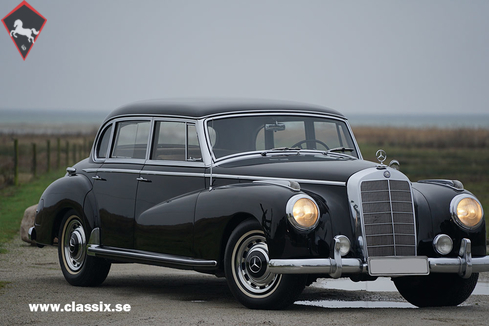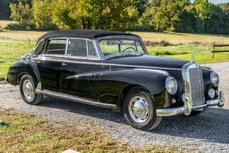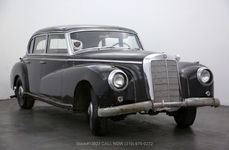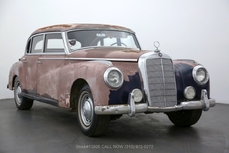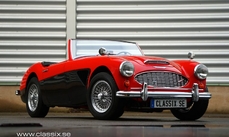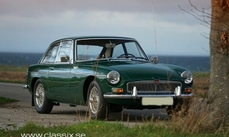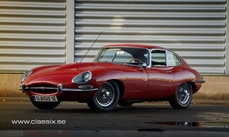Mercedes-Benz 300 W186 Adenauer 1955
General description :
Mercedes 300 B W186 Adenauer 1955 for sale
Exterior: Original black paint with an incredible depth. Room and rubber details are very close to perfect. A big black Mercedes like this almost needs tyres with a thin white stripe if you do not like it, these can be turned inwards
Interior: This car has an all original interior in close to perfect condition. I would think that it is very rare to find a Mercedes from 1955 with an original interior in such great condition as this one.
Engine/History: This car that had the licence plate O39409 was bought new in July 27, 1955, by Lundberg Bilstation, a limousine service company in Göteborg (Gothenburg), Sweden. Customers were large industrial companies and companies in shipping industry in Göteborg. It should also have been used as transport to other national and international celebrities. After 15 years of distinguished service, it was in September 11th 1970 sold to Harry Carlsson. The car had then run 110,000 km. Harry was the owner of Kallebäcks åkeri, a road carrier company in Göteborg which he founded in 1928 and now had developed to a substantial size. His son has mentioned that Harry was very pedantic about the car and maintained it in very good condition. At that time Harry lived in Tvååker south of Göteborg and the car got the licence plate N39409. In 1973, the licence plate was replaced by the new type.
In 1977 Harry passed away and the car that still was in very god shape, as stated by his son, was sold to Alf in Kullavik. The care had now run 205,000 km. Alf was a Mercedes collector and did some work on the car. He has stated that he had a high-quality paintwork done on the car. He had also the chassis thoroughly cleaned e.g. taking old body coat away and painting it.
In October 28, 1995 the car with 209,000 km on the meter, was sold to Ingemar in Ulricehamn. He is a car collector and owner of Ulricehamns Bilexpo, which used to be the local Mercedes dealer.
In October 13, 2002 the car was bought by Stanley in Västerås. It had then 210,200 km on the meter. Stanley is another Swedish car collector.
The present owner, also being a Mercedes collector, bought the car in February 3rd, 2009. The meter then showed 215,000 km. He rebuilt the engine by boring the cylinders and putting new pistons in. The crankshaft was grinded, and all bearings replaced. The cylinder top was grinded, and all valves were checked and found ok. All valve guides were replaced and valves and valve seats grinded. The motor rubber mounts were replaced. The engine now runs very well, with oil pressure according to specification and without excessive mechanical noise. The central lubrication system has been renovated. The brake system has been through a thorough overhaul. A tailored stainless-steel exhaust system (Ferita) has been mounted. The battery was replaced in 2019. The car has now run about 218,000 km.
http://www.classix.se/cars-for-sale/item/545-mercedes-300-adenauer-1955
1955 Mercedes-Benz 300 W186 Adenauer is listed sold on ClassicDigest in Saxtorp by Auto Dealer for €69000.
Car Facts
Car type : Car Make : Mercedes-Benz Model : 300 W186 Adenauer Engine size : 0.0 Model Year : 1955 Sub type : Sedan Location : Saxtorp
Sold
Seller Information
Sold
People who viewed this Mercedes-Benz 300 W186 Adenauer also viewed similar Mercedes-Benz listed at ClassicDigest
Other cars listed for sale by this dealer
About Mercedes-Benz
In the annals of automotive history, the journey of Mercedes-Benz is a tale that unfolds with the ingenuity of its founding pioneers. In the year 1886, Karl Benz crafted the Benz Patent Motorwagen, a creation that would go down in history as the world's inaugural automobile. Unbeknownst to him, this moment marked the genesis of what would evolve into the most illustrious premium car manufacturer globally. The financial underpinning of this pioneering venture, interestingly, was provided by Karl Benz's wife, Bertha Benz, demonstrating a remarkable partnership that would set the tone for Mercedes-Benz's legacy.A parallel narrative emerged not far away, as Daimler-Motoren-Gesellschaft, founded by Gottlieb Daimler and Wilhelm Maybach, entered the scene. In 1901, they unveiled their automobile under the now-famous moniker "Mercedes," meaning "godsend" in Spanish. This name was bestowed upon the car at the behest of Emil Jellinek's daughter, the distributor for Daimler-Motoren-Gesellschaft. The wheels of innovation were set in motion.
Fast forward to 1926, a pivotal year that witnessed the merger of Daimler with Benz & Cie., culminating in the birth of Daimler-Benz. The amalgamation saw the adoption of "Mercedes-Benz" as the distinguished trademark for their automobiles, fusing the legacies of two visionary entities into one.
Contrary to perceptions of conservatism, the trajectory of Daimler-Benz unfolds as a chronicle of industry firsts. From the introduction of the honeycomb radiator to the float carburetor, and the pioneering implementation of four-wheel brakes in 1924, Daimler-Benz consistently pushed the boundaries of automotive innovation. The diesel-powered Mercedes-Benz 260 D in 1936 marked the inception of diesel engines in passenger cars. The iconic Mercedes-Benz 300SL Gullwing made history as the first car with direct fuel injection, albeit the Gutbrod's tiny 2-stroke engine can claim precedence.
Safety innovations became a hallmark, with Béla Barényi's patented safety cell design in the "Ponton"-models in 1951, featuring front and rear crumple zones. The W116 450SEL 6.9 saw the introduction of the Anti-Lock Brake system (ABS), another pioneering safety feature. From the first production airbags and beyond, the legacy of "firsts" continued to be etched into the fabric of Daimler-Benz.
Over its centennial journey, Mercedes-Benz has not merely produced cars but has sculpted automotive icons. The SSKL, 710 SSK Trossi Roadster, 770K Grosser, 540K Spezial Roadster, 300SL Gullwing, w100 600 Pullman, w111 280SE 3.5 Flachkühler, w113 230SL Pagoda, w109 300 SEL 6.3, and w201 2.3-16 Cosworth stand testament to the brand's commitment to engineering excellence.
The roaring Silver Arrows, or "Silberpfeile," including the W 25, W 125, W154, W165, and W196, created a legacy of dominance on the racetrack. These machines were not merely cars; they were expressions of precision, speed, and an indomitable spirit that left their competitors in the dust.
As Mercedes-Benz marches into the future, it does so not just as an automaker but as a custodian of a legacy, a torchbearer of innovation, and a beacon of automotive excellence. The road ahead is sure to witness the continued fusion of cutting-edge technology, timeless design, and an unwavering commitment to setting new standards in the world of automobiles.
One luminary figure who left an indelible mark was Béla Barényi, often heralded as the "father of passive safety" for his pioneering work in safety engineering. His patented safety cell design, featuring front and rear crumple zones, became a hallmark of Mercedes-Benz's commitment to occupant safety, setting new standards that reverberated throughout the automotive world.
Moving through the chronicles, the collaborative genius of Wilhelm Maybach, alongside Gottlieb Daimler, laid the foundation for Daimler-Motoren-Gesellschaft. Their innovations not only birthed the first Mercedes but established a culture of relentless pursuit of technological excellence that remains integral to Mercedes-Benz's DNA.
In the post-merger era of 1926, Ferdinand Porsche emerged as a prominent figure within Mercedes-Benz. His work on the Mercedes-Benz S-Type, a supercharged race car, garnered acclaim and set the stage for a legacy that extended far beyond the marque. Porsche's impact would later extend to his eponymous company, but his influence at Mercedes-Benz during those formative years was pivotal.
As the 20th century progressed, the legendary Rudolf Uhlenhaut emerged as a key figure. Uhlenhaut, an accomplished engineer and the driving force behind the iconic Silver Arrows, played a crucial role in Mercedes-Benz's dominance in motorsports. His engineering prowess and attention to detail were instrumental in creating some of the most formidable racing cars of the era.
In the latter half of the century, figures like Bruno Sacco, the head of design at Mercedes-Benz from 1975 to 1999, left an indelible imprint on the brand's aesthetic identity. Sacco's design philosophy, characterized by clean lines and timeless elegance, shaped iconic models like the W126 S-Class and the W201 190E, solidifying Mercedes-Benz's reputation for luxury and sophistication.
The narrative would be incomplete without acknowledging the contributions of engineers like Hans Scherenberg, whose leadership in the 1970s ushered in a new era of technological innovation at Mercedes-Benz. Scherenberg's tenure saw the development of groundbreaking technologies, including the Anti-Lock Brake system (ABS) and the introduction of airbags in production cars.
